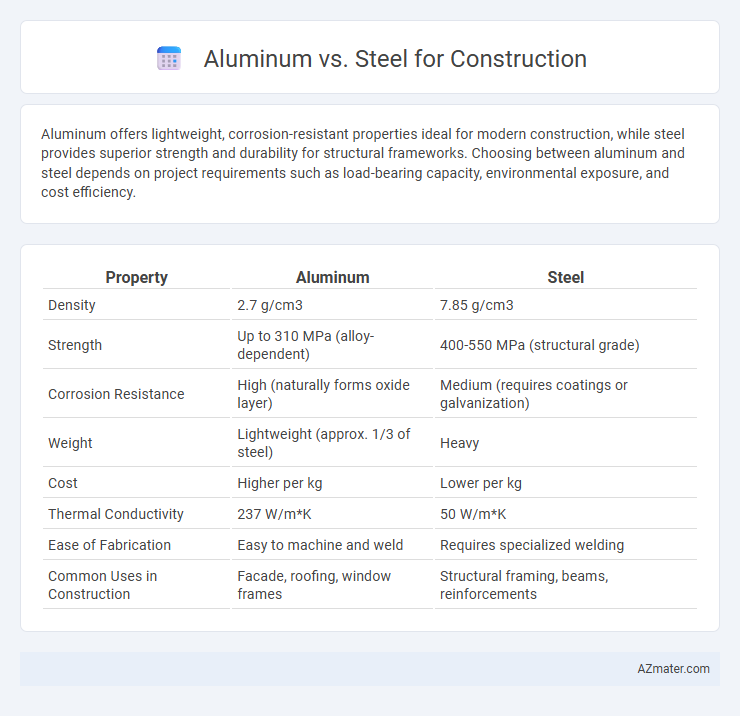Aluminum offers lightweight, corrosion-resistant properties ideal for modern construction, while steel provides superior strength and durability for structural frameworks. Choosing between aluminum and steel depends on project requirements such as load-bearing capacity, environmental exposure, and cost efficiency.
Table of Comparison
| Property | Aluminum | Steel |
|---|---|---|
| Density | 2.7 g/cm3 | 7.85 g/cm3 |
| Strength | Up to 310 MPa (alloy-dependent) | 400-550 MPa (structural grade) |
| Corrosion Resistance | High (naturally forms oxide layer) | Medium (requires coatings or galvanization) |
| Weight | Lightweight (approx. 1/3 of steel) | Heavy |
| Cost | Higher per kg | Lower per kg |
| Thermal Conductivity | 237 W/m*K | 50 W/m*K |
| Ease of Fabrication | Easy to machine and weld | Requires specialized welding |
| Common Uses in Construction | Facade, roofing, window frames | Structural framing, beams, reinforcements |
Introduction to Aluminum and Steel in Construction
Aluminum in construction offers lightweight durability, corrosion resistance, and ease of fabrication, making it ideal for modern architectural designs and structural components. Steel provides exceptional strength, versatility, and cost-effectiveness, commonly used for frameworks, reinforcements, and load-bearing structures. The choice between aluminum and steel depends on project requirements including weight constraints, environmental exposure, and budget considerations.
Material Properties: Aluminum vs Steel
Aluminum offers a high strength-to-weight ratio and excellent corrosion resistance, making it ideal for lightweight structural components in construction projects. Steel provides superior tensile strength and durability, essential for load-bearing frameworks and heavy-duty applications. While aluminum is more flexible and resistant to rust, steel generally outperforms in terms of hardness and cost-efficiency for large-scale construction.
Structural Strength and Durability Comparison
Aluminum offers a higher strength-to-weight ratio compared to steel, making it ideal for lightweight structural applications where corrosion resistance is critical, especially in coastal or humid environments. Steel exhibits superior tensile strength and impact resistance, providing enhanced load-bearing capacity and longevity in heavy-duty construction projects. While aluminum resists rust and requires less maintenance, steel's durability under extreme stress and fire conditions often results in longer structural lifespan.
Weight Differences and Impact on Design
Aluminum is significantly lighter than steel, with a density of approximately 2.7 g/cm3 compared to steel's 7.85 g/cm3, which greatly reduces the overall structural weight and foundation load. This weight difference allows for easier handling, quicker installation, and the potential for more innovative architectural designs, including longer spans and reduced support requirements. Engineers often leverage aluminum's lightweight properties to enhance seismic performance and improve transportation efficiency of construction materials.
Corrosion Resistance and Maintenance Needs
Aluminum offers superior corrosion resistance compared to steel due to its natural oxide layer, making it ideal for environments with high moisture or salt exposure. Steel requires protective coatings or galvanization to prevent rust, leading to higher maintenance costs over time. Choosing aluminum reduces long-term maintenance needs and extends the lifespan of construction elements in corrosive conditions.
Cost Analysis: Aluminum vs Steel
Aluminum typically incurs higher initial costs compared to steel due to its more complex refining and manufacturing processes, with prices averaging around $1.50 to $2.50 per pound versus steel's $0.50 to $0.80 per pound. However, aluminum's lower weight can reduce transportation and labor expenses, offering potential long-term savings in projects where weight is a critical factor. Steel, favored for its durability and lower upfront cost, remains the more economical choice for large-scale construction projects with budget constraints.
Sustainability and Environmental Impact
Aluminum offers significant advantages in sustainability over steel due to its high recyclability and lower weight, which reduces transportation emissions and energy consumption during handling. Steel production typically generates higher carbon emissions and relies on more energy-intensive processes, although advances in recycled steel usage help mitigate some environmental impacts. Choosing aluminum in construction projects supports long-term ecological benefits by minimizing resource depletion and promoting circular economy principles.
Ease of Fabrication and Installation
Aluminum offers superior ease of fabrication and installation compared to steel due to its lightweight nature and excellent malleability, allowing for faster cutting, shaping, and welding processes. Steel, while stronger, requires more specialized equipment and labor for fabrication and installation, increasing time and costs on construction sites. Choosing aluminum can significantly reduce project timelines and labor expenses in construction applications requiring complex designs or rapid assembly.
Common Construction Applications for Aluminum and Steel
Steel dominates construction applications requiring high strength and durability, such as structural frameworks, beams, and reinforcements for commercial buildings and bridges. Aluminum is favored in applications demanding lightweight materials and corrosion resistance, including window frames, roofing panels, and cladding systems. Both metals are widely used, with steel providing robust support for heavy loads and aluminum excelling in architectural features and exterior finishes.
Choosing the Right Material for Your Project
Aluminum offers corrosion resistance, lightweight properties, and ease of fabrication, making it ideal for projects requiring reduced structural weight and enhanced durability in harsh environments. Steel provides superior strength, cost-effectiveness, and high load-bearing capacity, preferred for heavy-duty construction and large-scale frameworks. Selecting the right material depends on factors like project requirements, budget constraints, environmental exposure, and structural demands.

Infographic: Aluminum vs Steel for Construction
 azmater.com
azmater.com